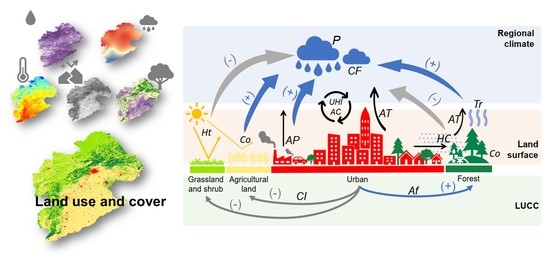Urbanization-Driven Changes in Land-Climate Dynamics: A Case Study of Haihe River Basin, China
Abstract
:1. Introduction
2. Materials and Methods
2.1. Study Area
2.2. Data Source and Data Processing
2.3. Statistical Analysis
3. Results
3.1. Land Use and Cover Change
3.2. Temporal Trends of the Land Surface and the Regional Climate Indicators
3.3. Urbanization Drives Land-Climate Dynamics
4. Discussion
4.1. Urbanization Drives the Land Use and Cover Change in the Haihe River Basin
4.2. The LUCC Alters the Rigional Climate
4.3. The Recommendations on the Land Planning and Management
5. Conclusions
Supplementary Materials
Author Contributions
Funding
Acknowledgments
Conflicts of Interest
References
- Pontius, R.G.; Shusas, E.; McEachern, M. Detecting Important Categorical Land Changes While Accounting for Persistence. Agric. Ecosyst. Environ. 2004, 101, 251–268. [Google Scholar] [CrossRef]
- Bren d’Amour, C.; Reitsma, F.; Baiocchi, G.; Barthel, S.; Güneralp, B.; Erb, K.-H.; Haberl, H.; Creutzig, F.; Seto, K.C. Future Urban Land Expansion and Implications for Global Croplands. Proc. Natl. Acad. Sci. USA 2017, 114, 8939–8944. [Google Scholar] [CrossRef] [PubMed] [Green Version]
- Song, X.-P.; Hansen, M.C.; Stehman, S.V.; Potapov, P.V.; Tyukavina, A.; Vermote, E.F.; Townshend, J.R. Global Land Change from 1982 to 2016. Nature 2018, 560, 639–643. [Google Scholar] [CrossRef] [PubMed]
- Teuling, A.J.; Seneviratne, S.I.; Stockli, R.; Reichstein, M.; Moors, E.; Ciais, P.; Luyssaert, S.; Van Den Hurk, B.; Ammann, C.; Bernhofer, C.; et al. Contrasting Response of European Forest and Grassland Energy Exchange to Heatwaves. Nat. Geosci. 2010, 722–727. [Google Scholar] [CrossRef]
- Anderson, R.G.; Canadell, J.G.; Randerson, J.T.; Jackson, R.B.; Hungate, B.A.; Baldocchi, D.D.; Ban-Weiss, G.A.; Bonan, G.B.; Caldeira, K.; Cao, L. Biophysical Considerations in Forestry for Climate Protection. Front. Ecol. Environ. 2011, 9, 174–182. [Google Scholar] [CrossRef] [Green Version]
- Li, Y.; Liu, C.; Yu, W.; Tian, D.; Bai, P. Response of streamflow to environmental changes: A Budyko-type analysis based on 144 river basins over China. Sci. Total Environ. 2019, 664, 824–833. [Google Scholar] [CrossRef]
- Turner, P.A.; Field, C.B.; Lobell, D.B.; Sanchez, D.L.; Mach, K.J. Unprecedented Rates of Land-Use Transformation in Modelled Climate Change Mitigation Pathways. Nat. Sustain. 2018, 1, 240–245. [Google Scholar] [CrossRef]
- Tian, H.; Chen, G.; Liu, M.; Zhang, C.; Sun, G.; Lu, C.; Xu, X.; Ren, W.; Pan, S.; Chappelka, A. Model Estimates of Net Primary Productivity, Evapotranspiration, and Water Use Efficiency in the Terrestrial Ecosystems of the Southern United States during 1895–2007. For. Ecol. Manag. 2010, 259, 1311–1327. [Google Scholar] [CrossRef]
- Haddeland, I.; Clark, D.B.; Franssen, W.; Ludwig, F.; Voß, F.; Arnell, N.W.; Bertrand, N.; Best, M.; Folwell, S.; Gerten, D.; et al. Multimodel Estimate of the Global Terrestrial Water Balance: Setup and First Results. J. Hydrometeorol. 2011, 12, 869–884. [Google Scholar] [CrossRef] [Green Version]
- van Vliet, M.T.H.; Flörke, M.; Wada, Y. Quality Matters for Water Scarcity. Nat. Geosci. 2017, 10, 800. [Google Scholar] [CrossRef]
- Xiao, Z.; Liang, S.; Wang, J.; Chen, P.; Yin, X.; Zhang, L.; Song, J. Use of General Regression Neural Networks for Generating the GLASS Leaf Area Index Product from Time-Series MODIS Surface Reflectance. IEEE Trans. Geosci. Remote Sens. 2013, 52, 209–223. [Google Scholar] [CrossRef]
- UCL-Geomatics. Land Cover CCI Product User Guide (Version 2.0). 2017. Available online: https://www.esa-landcover-cci.org/?q=webfm_send/84 (accessed on 20 August 2020).
- Lee, X.; Goulden, M.L.; Hollinger, D.Y.; Barr, A.; Black, T.A.; Bohrer, G.; Bracho, R.; Drake, B.; Goldstein, A.; Gu, L.; et al. Observed Increase in Local Cooling Effect of Deforestation at Higher Latitudes. Nature 2011, 479, 384. [Google Scholar] [CrossRef] [PubMed]
- Zhao, L.; Lee, X.; Smith, R.B.; Oleson, K. Strong Contributions of Local Background Climate to Urban Heat Islands. Nature 2014, 511, 216. [Google Scholar] [CrossRef] [PubMed]
- Bonan, G. Ecological Climatology: Concepts and Applications, 3rd ed.; Cambridge University Press: Cambridge, UK, 2015. [Google Scholar] [CrossRef]
- Li, Z.; Liu, X.; Ma, T.; Kejia, D.; Zhou, Q.; Yao, B.; Niu, T. Retrieval of the Surface Evapotranspiration Patterns in the Alpine Grassland-Wetland Ecosystem Applying SEBAL Model in the Source Region of the Yellow River, China. Ecol. Model. 2013, 270. [Google Scholar] [CrossRef]
- Karimi, P.; Bastiaanssen, W.G.M. Spatial Evapotranspiration, Rainfall and Land Use Data in Water Accounting—Part 1: Review of the Accuracy of the Remote Sensing Data. Hydrol. Earth Syst. Sci. 2015, 19, 507–532. [Google Scholar] [CrossRef] [Green Version]
- Cao, C.; Lee, X.; Liu, S.; Schultz, N.; Xiao, W.; Zhang, M.; Zhao, L. Urban Heat Islands in China Enhanced by Haze Pollution. Nat. Commun. 2016, 7, 12509. [Google Scholar] [CrossRef]
- Yang, Y.; Zheng, H.; Xu, W.; Zhang, L.; Ouyang, Z. Temporal Changes in Multiple Ecosystem Services and Their Bundles Responding to Urbanization and Ecological Restoration in the Beijing–Tianjin–Hebei Metropolitan Area. Sustainability 2019. [Google Scholar] [CrossRef] [Green Version]
- Luo, K.; Tao, F.; Moiwo, J.P.; Xiao, D. Attribution of Hydrological Change in Heihe River Basin to Climate and Land Use Change in the Past Three Decades. Sci. Rep. 2016, 6, 33704. [Google Scholar] [CrossRef] [Green Version]
- Zhao, H.; Wang, Q.-R.; Fan, W.; Song, G.-H. The Relationship between Secondary Forest and Environmental Factors in the Southern Taihang Mountains. In Scientific Reports; Nature Publishing Group: London, UK, 2017; pp. 16410–16431. [Google Scholar] [CrossRef]
- Chu, X.; Zhan, J.; Li, Z.; Zhang, F.; Qi, W. Assessment on Forest Carbon Sequestration in the Three-North Shelterbelt Program Region, China. J. Clean. Prod. 2019, 382–389. [Google Scholar] [CrossRef]
- Wang, Z.; Luo, Y.; Liu, C.; Xia, J.; Zhang, M. Spatial and Temporal Variations of Precipitation in Haihe River Basin, China: Six Decades of Measurements. Hydrol. Process. 2011, 25, 2916–2923. [Google Scholar] [CrossRef]
- Liu, B.; Yan, Z.; Sha, J.; Li, S. Drought Evolution Due to Climate Change and Links to Precipitation Intensity in the Haihe River Basin. Water 2017. [Google Scholar] [CrossRef] [Green Version]
- Yang, S.; Chen, B.; Fath, B. Trans-Boundary Total Suspended Particulate Matter (TSPM) in Urban Ecosystems. Ecol. Model. 2015, 318, 59–63. [Google Scholar] [CrossRef]
- Cui, X.; Fang, C.; Liu, H.; Liu, X. Assessing Sustainability of Urbanization by a Coordinated Development Index for an Urbanization-Resources-Environment Complex System: A Case Study of Jing-Jin-Ji Region, China. Ecol. Indic. 2019, 96, 383–391. [Google Scholar] [CrossRef]
- Li, Z.; Wang, Z.; Liu, X.; Fath, B.; Liu, X.; Xu, Y.; Hutjes, R.; Kroeze, C. Causal Relationship in the Interaction between Land Cover Change and Underlying Surface Climate in the Grassland Ecosystems in China. Sci. Total Environ. 2019, 647, 1080–1087. [Google Scholar] [CrossRef] [PubMed] [Green Version]
- Rodell, M.; Houser, P.R.; Jambor, U.; Gottschalck, J.; Mitchell, K.; Meng, C.-J.; Arsenault, K.; Cosgrove, B.; Radakovich, J.; Bosilovich, M.; et al. The Global Land Data Assimilation System. Bull. Am. Meteorol. Soc. 2004, 85, 381–394. [Google Scholar] [CrossRef] [Green Version]
- Platnick, S.; King, M.; Hubanks, P. MODIS Atmosphere L3 Monthly Product; NASA MODIS Adaptive Processing System; Goddard Space Flight Center: Greenbelt, MD, USA, 2015. [Google Scholar] [CrossRef]
- Hu, Y.; Zhen, L.; Zhuang, D. Assessment of Land-Use and Land-Cover Change in Guangxi, China. Sci. Rep. 2019, 9, 2189. [Google Scholar] [CrossRef] [PubMed] [Green Version]
- Qiu, B.; Li, H.; Tang, Z.; Chen, C.; Berry, J. How Cropland Losses Shaped by Unbalanced Urbanization Process? Land Use Policy 2020, 96, 104715. [Google Scholar] [CrossRef]
- Hao, Y.; Xu, Y.; Zhang, J.; Hu, X.; Huang, J.; Chang, C.-P.; Guo, Y. Relationship between Forest Resources and Economic Growth: Empirical Evidence from China. J. Clean. Prod. 2019, 214, 848–859. [Google Scholar] [CrossRef]
- Xiong, L.; Yu, C.; de Jong, M.; Wang, F.; Cheng, B. Economic Transformation in the Beijing-Tianjin-Hebei Region: Is It Undergoing the Environmental Kuznets Curve? Sustainability 2017, 9. [Google Scholar] [CrossRef] [Green Version]
- Xu, Q.; Dong, Y.; Yang, R. Urbanization Impact on Carbon Emissions in the Pearl River Delta Region: Kuznets Curve Relationships. J. Clean. Prod. 2018, 180, 514–523. [Google Scholar] [CrossRef]
- Dongfeng, Y.; Chengzhi, Y.; Ying, L. Urbanization and Sustainability in China: An Analysis Based on the Urbanization Kuznets-Curve. Plan. Theory 2013, 12, 391–405. [Google Scholar] [CrossRef]
- Vaca, R.A.; Golicher, D.J.; Cayuela, L.; Hewson, J.; Steininger, M. Evidence of Incipient Forest Transition in Southern Mexico. PLoS ONE 2012, 7, e42309. [Google Scholar] [CrossRef]
- Wang, C.; Gao, Q.; Wang, X.; Yu, M. Spatially Differentiated Trends in Urbanization, Agricultural Land Abandonment and Reclamation, and Woodland Recovery in Northern China. Sci. Rep. 2016, 6, 37658. [Google Scholar] [CrossRef] [Green Version]
- Qiu, B.; Chen, G.; Tang, Z.; Lu, D.; Wang, Z.; Chen, C. Assessing the Three-North Shelter Forest Program in China by a Novel Framework for Characterizing Vegetation Changes. ISPRS J. Photogramm. Remote Sens. 2017, 133, 75–88. [Google Scholar] [CrossRef]
- Li, Z.; Wu, W.; Liu, X.; Fath, B.D.; Sun, H.; Liu, X.; Xiao, X.; Cao, J. Land Use/Cover Change and Regional aClimate Change in an Arid Grassland Ecosystem of Inner Mongolia, China. Ecol. Model. 2017, 353, 86–94. [Google Scholar] [CrossRef]
- Li, Y.; Zhao, M.; Motesharrei, S.; Mu, Q.; Kalnay, E.; Li, S. Local Cooling and Warming Effects of Forests Based on Satellite Observations. Nat. Commun. 2015, 6, 6603. [Google Scholar] [CrossRef] [Green Version]
- Peng, S.-S.; Piao, S.; Zeng, Z.; Ciais, P.; Zhou, L.; Li, L.Z.; Myneni, R.B.; Yin, Y.; Zeng, H. Afforestation in China Cools Local Land Surface Temperature. Proc. Natl. Acad. Sci. USA 2014, 111, 2915–2919. [Google Scholar] [CrossRef] [PubMed] [Green Version]
- Wang, L.; Lee, X.; Schultz, N.; Chen, S.; Wei, Z.; Fu, C.; Gao, Y.; Yang, Y.; Lin, G. Response of Surface Temperature to Afforestation in the Kubuqi Desert, Inner Mongolia. J. Geophys. Res. Atmos. 2018, 123, 948–964. [Google Scholar] [CrossRef]
- Oehri, J.; Schmid, B.; Schaepman-Strub, G.; Niklaus, P.A. Terrestrial Land-Cover Type Richness Is Positively Linked to Landscape-Level Functioning. Nat. Commun. 2020, 11, 154. [Google Scholar] [CrossRef] [PubMed]
- Nagler, P.L.; Glenn, E.P.; Kim, H.; Emmerich, W.; Scott, R.L.; Huxman, T.E.; Huete, A.R. Relationship between Evapotranspiration and Precipitation Pulses in a Semiarid Rangeland Estimated by Moisture Flux Towers and MODIS Vegetation Indices. J. Arid Environ. 2007, 70, 443–462. [Google Scholar] [CrossRef]
- Bonan, G.B. Forests and Climate Change: Forcings, Feedbacks, and the Climate Benefits of Forests. Science 2008, 320, 1444–1449. [Google Scholar] [CrossRef] [PubMed] [Green Version]
- Sun, J.; Yu, X.; Wang, H.; Jia, G.; Zhao, Y.; Tu, Z.; Deng, W.; Jia, J.; Chen, J. Effects of Forest Structure on Hydrological Processes in China. J. Hydrol. 2018, 561, 187–199. [Google Scholar] [CrossRef]
- Lefcheck, J.S. PiecewiseSEM: Piecewise Structural Equation Modelling in r for Ecology, Evolution, and Systematics. Methods Ecol. Evol. 2016, 7, 573–579. [Google Scholar] [CrossRef]
- Aubrecht, C.; Gunasekera, R.; Ungar, J.; Ishizawa, O. Consistent yet Adaptive Global Geospatial Identification of Urban–Rural Patterns: The IURBAN Model. Remote Sens. Environ. 2016, 187, 230–240. [Google Scholar] [CrossRef] [Green Version]
- Pata, U.K. Renewable Energy Consumption, Urbanization, Financial Development, Income and CO2 Emissions in Turkey: Testing EKC Hypothesis with Structural Breaks. J. Clean. Prod. 2018, 187, 770–779. [Google Scholar] [CrossRef]
- Tang, H.; Liu, W.; Yun, W. Spatiotemporal Dynamics of Green Spaces in the Beijing–Tianjin–Hebei Region in the Past 20 Years. Sustainability 2018, 10, 2949. [Google Scholar] [CrossRef] [Green Version]
- Lei, H.; Yang, D.; Huang, M. Impacts of Climate Change and Vegetation Dynamics on Runoff in the Mountainous Region of the Haihe River Basin in the Past Five Decades. J. Hydrol. 2014, 511, 786–799. [Google Scholar] [CrossRef]
- Bonnesoeur, V.; Locatelli, B.; Guariguata, M.R.; Ochoa-Tocachi, B.F.; Vanacker, V.; Mao, Z.; Stokes, A.; Mathez-Stiefel, S.-L. Impacts of Forests and Forestation on Hydrological Services in the Andes: A Systematic Review. For. Ecol. Manag. 2019, 433, 569–584. [Google Scholar] [CrossRef] [Green Version]
- Bonan, G.B.; Patton, E.G.; Harman, I.N.; Oleson, K.W.; Finnigan, J.J.; Lu, Y.; Burakowski, E.A. Modeling Canopy-Induced Turbulence in the Earth System: A Unified Parameterization of Turbulent Exchange within Plant Canopies and the Roughness Sublayer (CLM-Ml V0). Geosci. Model Dev. 2018, 11, 1467–1496. [Google Scholar] [CrossRef] [Green Version]
- Li, E.; Endter-Wada, J.; Li, S. Dynamics of Utah’s Agricultural Landscapes in Response to Urbanization: A Comparison between Irrigated and Non-Irrigated Agricultural Lands. Appl. Geogr. 2019, 105, 58–72. [Google Scholar] [CrossRef]
- Wei, J.; Knoche, H.R.; Kunstmann, H. Contribution of Transpiration and Evaporation to Precipitation: An ET-Tagging Study for the Poyang Lake Region in Southeast China. J. Geophys. Res. Atmos. 2015, 120, 6845–6864. [Google Scholar] [CrossRef]
- Li, Q.; Wei, X.; Zhang, M.; Liu, W.; Fan, H.; Zhou, G.; Giles-Hansen, K.; Liu, S.; Wang, Y. Forest Cover Change and Water Yield in Large Forested Watersheds: A Global Synthetic Assessment. Ecohydrology 2017, 10, e1838. [Google Scholar] [CrossRef]
- Manoli, G.; Fatichi, S.; Schläpfer, M.; Yu, K.; Crowther, T.W.; Meili, N.; Burlando, P.; Katul, G.G.; Bou-Zeid, E. Magnitude of Urban Heat Islands Largely Explained by Climate and Population. Nature 2019, 573, 55–60. [Google Scholar] [CrossRef] [PubMed]
- Huang, R.-J.; Zhang, Y.; Bozzetti, C.; Ho, K.-F.; Cao, J.-J.; Han, Y.; Daellenbach, K.R.; Slowik, J.G.; Platt, S.M.; Canonaco, F.; et al. High Secondary Aerosol Contribution to Particulate Pollution during Haze Events in China. Nature 2014, 514, 218–222. [Google Scholar] [CrossRef] [PubMed] [Green Version]
- Li, Z.; Wang, Y.; Guo, J.; Zhao, C.; Cribb, M.C.; Dong, X.; Fan, J.; Gong, D.; Huang, J.; Jiang, M.; et al. East Asian Study of Tropospheric Aerosols and Their Impact on Regional Clouds, Precipitation, and Climate (EAST-AIRCPC). J. Geophys. Res. Atmos. 2019, 124, 13026–13054. [Google Scholar] [CrossRef] [Green Version]
- Ke, X.; van Vliet, J.; Zhou, T.; Verburg, P.H.; Zheng, W.; Liu, X. Direct and Indirect Loss of Natural Habitat Due to Built-up Area Expansion: A Model-Based Analysis for the City of Wuhan, China. Land Use Policy 2018, 74, 231–239. [Google Scholar] [CrossRef]
- Qianwen, C.; Penghui, J.; Lingyan, C.; Jinxia, S.; Yunqian, Z.; Liyan, W.; Manchun, L.; Feixue, L.; Axing, Z.; Dong, C. Delineation of a Permanent Basic Farmland Protection Area around a City Centre: Case Study of Changzhou City, China. Land Use Policy 2017, 60, 73–89. [Google Scholar] [CrossRef]
- Peng, J.; Jia, J.; Liu, Y.; Li, H.; Wu, J. Seasonal Contrast of the Dominant Factors for Spatial Distribution of Land Surface Temperature in Urban Areas. Remote Sens. Environ. 2018, 215, 255–267. [Google Scholar] [CrossRef]
- Jiang, Y.; Zevenbergen, C.; Fu, D. Understanding the Challenges for the Governance of China’s “Sponge Cities” Initiative to Sustainably Manage Urban Stormwater and Flooding. Nat. Hazards 2017, 89, 521–529. [Google Scholar] [CrossRef]
- Dai, L.; Wörner, R.; van Rijswick, H.F.M.W. Rainproof Cities in the Netherlands: Approaches in Dutch Water Governance to Climate-Adaptive Urban Planning. Int. J. Water Resour. Dev. 2018, 34, 652–674. [Google Scholar] [CrossRef] [Green Version]
- Cui, X.; Guo, X.; Wang, Y.; Wang, X.; Zhu, W.; Shi, J.; Lin, C.; Gao, X. Application of Remote Sensing to Water Environmental Processes under a Changing Climate. J. Hydrol. 2019, 574, 892–902. [Google Scholar] [CrossRef]
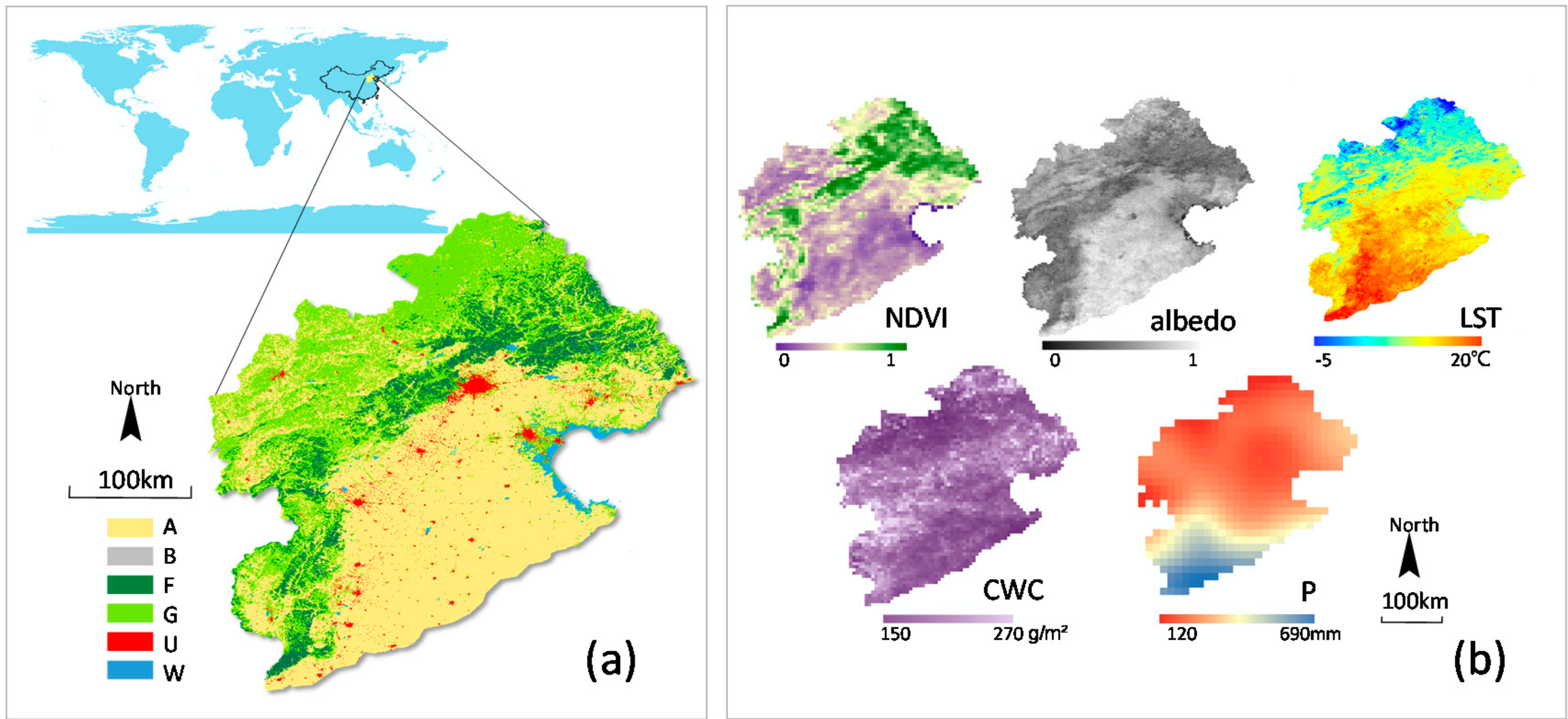
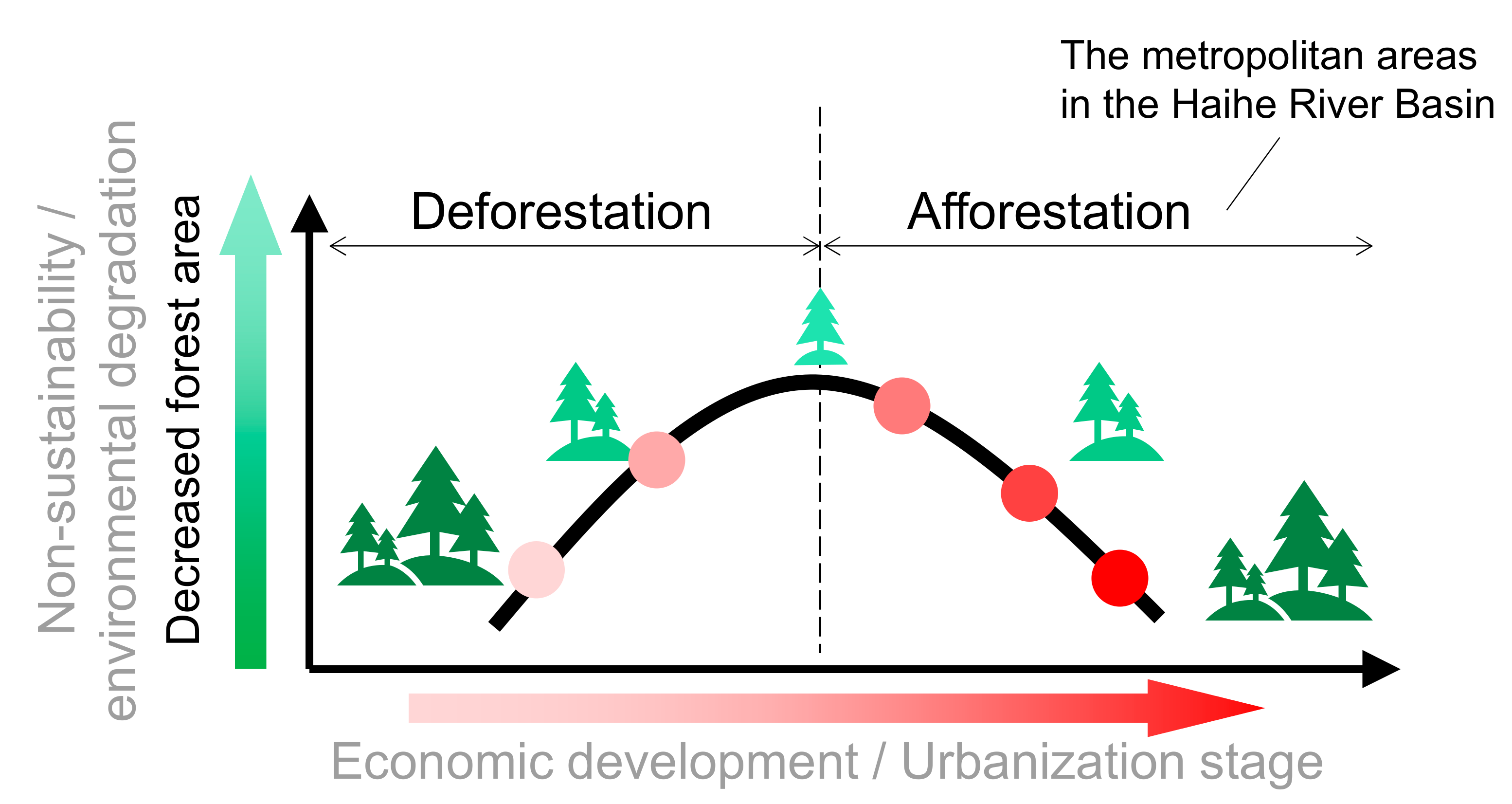
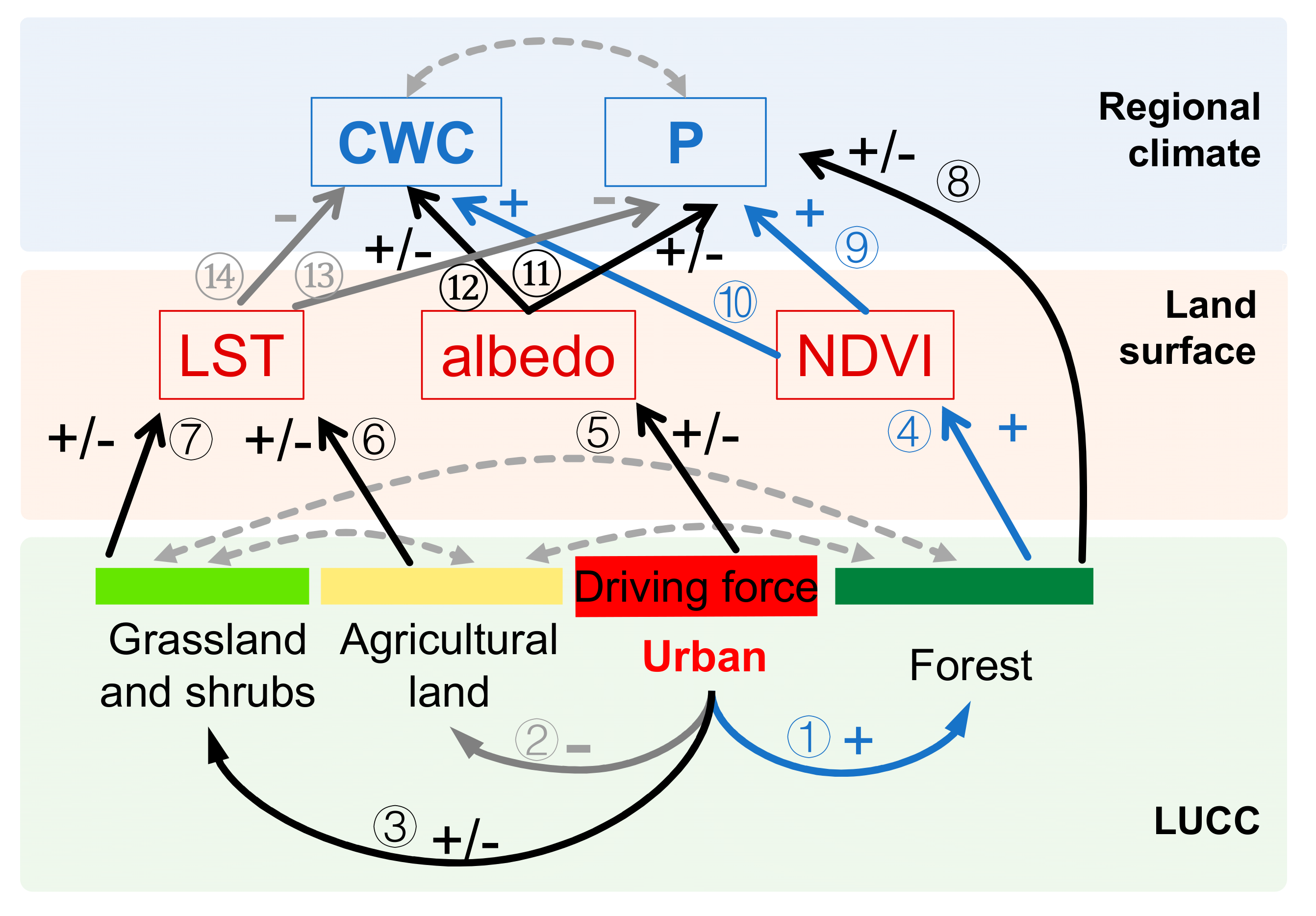
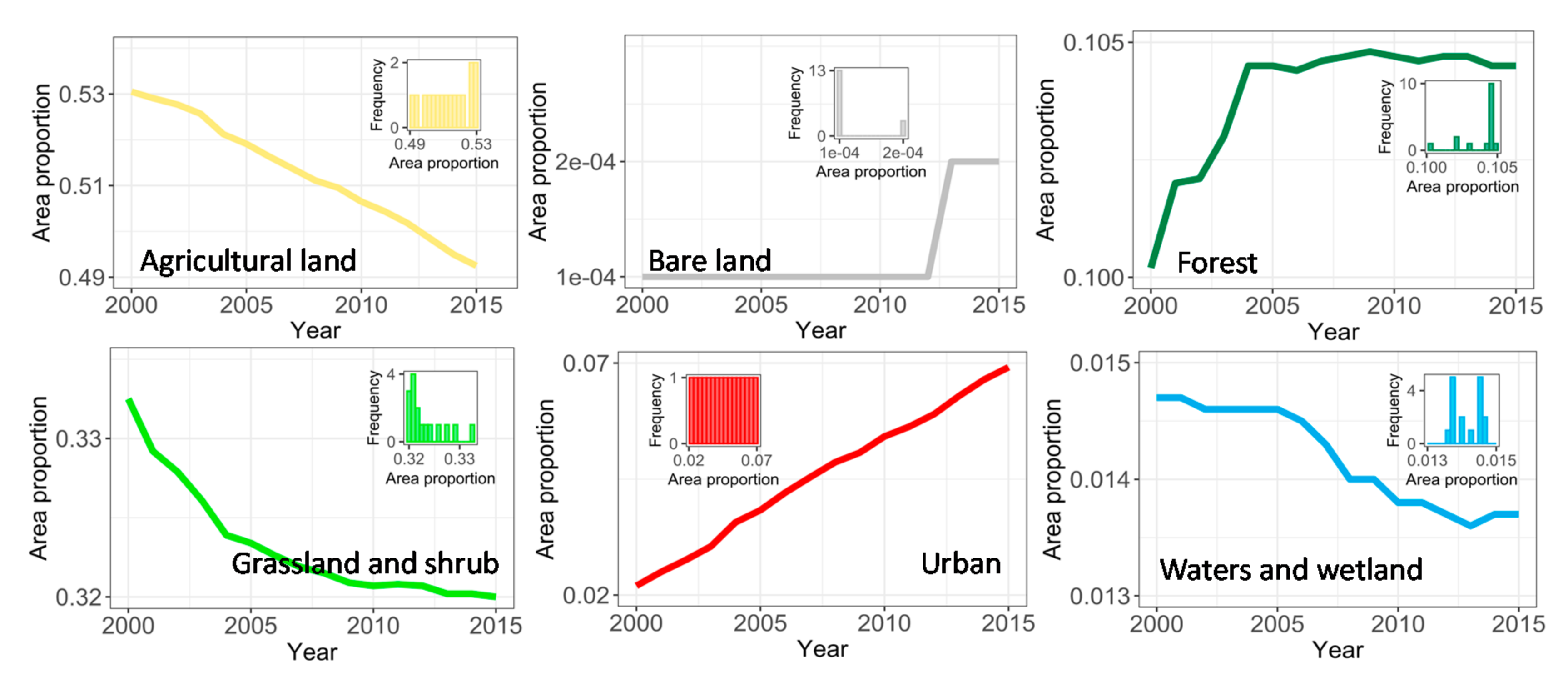
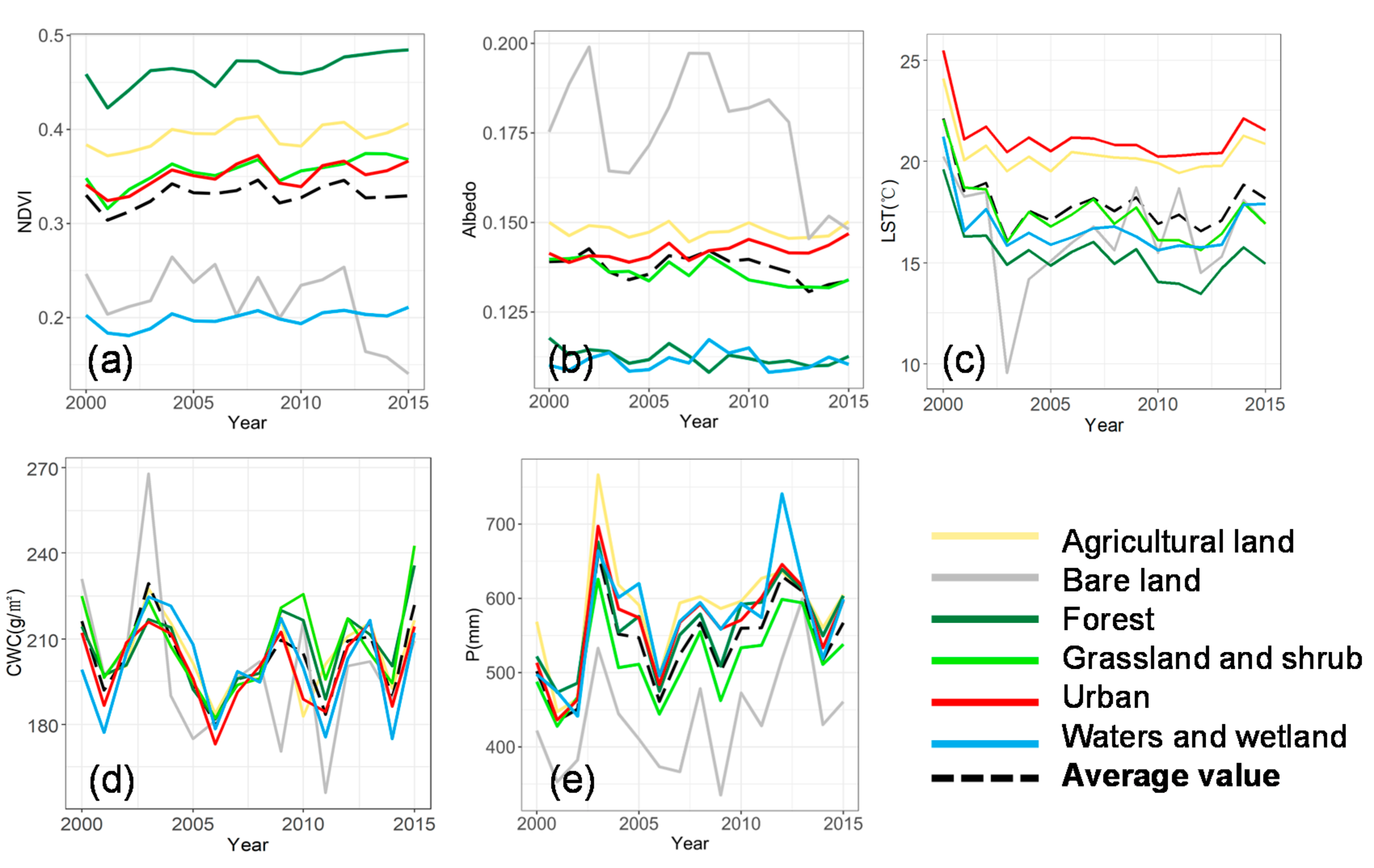
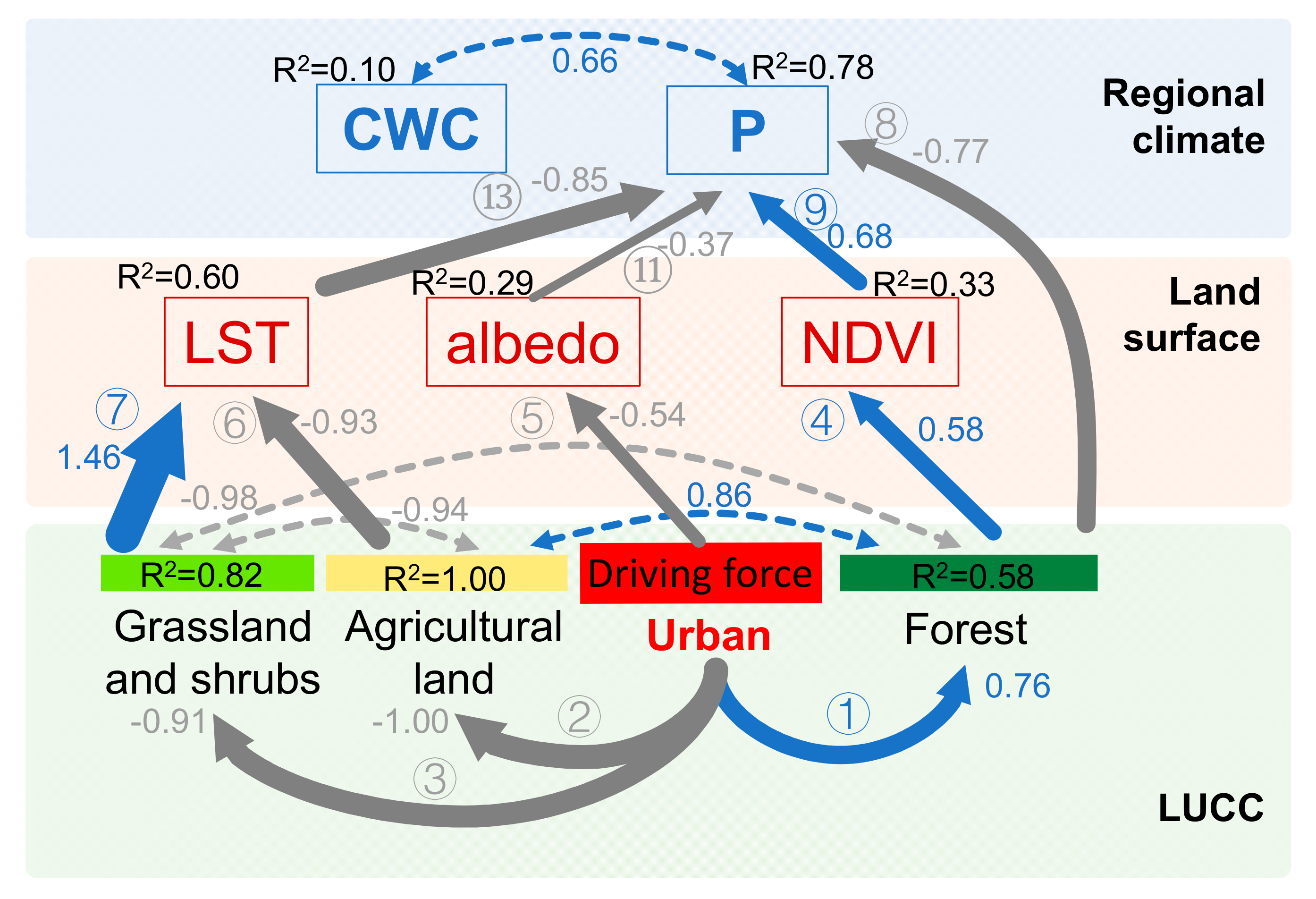

| Subsystem | Pathway | Process | Relationship | References |
|---|---|---|---|---|
| LUCC | ① U→F | Afforestation | − | [3,32,33,35,36,37,38] |
| ③ U→A | Crop intensification | + | [3,30,31] | |
| LUCC→land surface LUCC→regional climate | ④ F→NDVI | Vegetational biomass growth | + | [39] |
| ⑤ U→albedo | Land surface roughness change | +/− | [16,42,43] | |
| ⑥ A→LST, ⑦ G→LST | Land surface energy balance | +/− | [4,27,39,40,41] | |
| ⑧ F→P | Eco-hydrological process | +/− | [45,46] | |
| Land surface→regional climate | ⑨ NDVI→P, ⑩ NDVI→CWC | Evapotranspiration promoting the regional hydrological cycle | + | [27,44] |
| ⑬ LST→P, ⑭ LST→CWC | Land surface heating drying the regional air | − | [15,39] |
| Indicators | Statistical Index | Different Land Use and Cover Types | Average of All Land Use and Cover Types | |||||
|---|---|---|---|---|---|---|---|---|
| Agricultural Land | Bare Land | Forest | Grassland and Shrub | Urban | Waters and Wetland | |||
| NDVI | R2 | ↑0.29 | ↓0.26 | ↑0.57 | ↑0.55 | ↑0.39 | ↑0.41 | 0.14↑ |
| p-value | 0.032 * | 0.045 * | 0.0007 *** | 0.001 ** | 0.0096 ** | 0.007 ** | 0.15 | |
| Mean | 0.39 | 0.22 | 0.46 | 0.36 | 0.35 | 0.20 | 0.32 | |
| CV | 3.3% | 17.2% | 3.5% | 4.2% | 3.9% | 4.3% | 3.42% | |
| albedo | R2 | ↓0.026 | ↓0.23 | ↓0.34 | ↓0.56 | ↑0.44 | ↑0.002 | 0.26↓ |
| p-value | 0.55 | 0.06 | 0.018 * | 0.0009 *** | 0.005 ** | 0.86 | 0.044 * | |
| Mean | 0.15 | 0.18 | 0.11 | 0.14 | 0.14 | 0.11 | 0.14 | |
| CV | 1.3% | 9.7% | 2.1% | 2.4% | 1.6% | 2.4% | 2.53% | |
| LST (°C) | R2 | ↓0.088 | ↓<0.001 | ↓0.39 | ↓0.33 | ↓0.15 | ↓0.085 | 0.13↓ |
| p-value | 0.27 | 0.98 | 0.0099 ** | 0.019* | 0.14 | 0.27 | 0.16 | |
| Mean | 20.39 | 16.36 | 15.41 | 17.43 | 21.20 | 16.78 | 17.93 | |
| CV | 5.5% | 15.5% | 9.1% | 8.9% | 6.0% | 8.3% | 7.67% | |
| CWC (g/m2) | R2 | ↓0.0037 | ↓0.096 | ↑0.074 | ↑0.022 | ↓0.0014 | ↓0.0043 | 0.003↓ |
| p-value | 0.82 | 0.24 | 0.31 | 0.59 | 0.89 | 0.81 | 0.85 | |
| Mean | 204.37 | 199.24 | 206.27 | 207.97 | 200.27 | 200.32 | 202.07 | |
| CV | 6.3% | 13.0% | 6.8% | 7.8% | 6.9% | 8.3% | 6.72% | |
| P (mm) | R2 | ↑0.071 | ↑0.16 | ↑0.22 | ↑0.18 | ↑0.18 | ↑0.19 | 0.18↑ |
| p-value | 0.32 | 0.13 | 0.08 | 0.10 | 0.10 | 0.09 | 0.10 | |
| Mean | 585.63 | 437.99 | 561.98 | 518.61 | 564.81 | 572.77 | 540.30 | |
| CV | 12.6% | 16.3% | 10.4% | 10.8% | 11.9% | 13.2% | 11.57% | |
| Pathway | Coefficient Product |
|---|---|
| U→F→NDVI→P | 0.30 |
| U→F→P | −0.59 |
| U→albedo→P | 0.20 |
| U→G→LST→P | 1.13 |
| U→A→LST→P | −0.79 |
| Total U→P | 0.25 |
© 2020 by the authors. Licensee MDPI, Basel, Switzerland. This article is an open access article distributed under the terms and conditions of the Creative Commons Attribution (CC BY) license (http://creativecommons.org/licenses/by/4.0/).
Share and Cite
Li, Z.; Xu, Y.; Sun, Y.; Wu, M.; Zhao, B. Urbanization-Driven Changes in Land-Climate Dynamics: A Case Study of Haihe River Basin, China. Remote Sens. 2020, 12, 2701. https://doi.org/10.3390/rs12172701
Li Z, Xu Y, Sun Y, Wu M, Zhao B. Urbanization-Driven Changes in Land-Climate Dynamics: A Case Study of Haihe River Basin, China. Remote Sensing. 2020; 12(17):2701. https://doi.org/10.3390/rs12172701
Chicago/Turabian StyleLi, Zhouyuan, Yanjie Xu, Yingbao Sun, Mengfan Wu, and Bin Zhao. 2020. "Urbanization-Driven Changes in Land-Climate Dynamics: A Case Study of Haihe River Basin, China" Remote Sensing 12, no. 17: 2701. https://doi.org/10.3390/rs12172701




